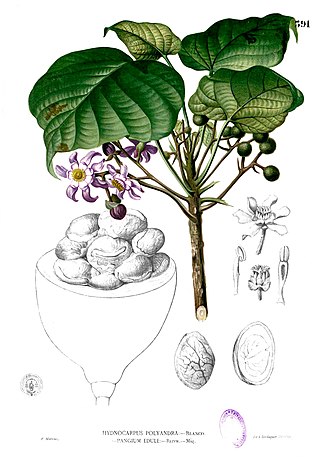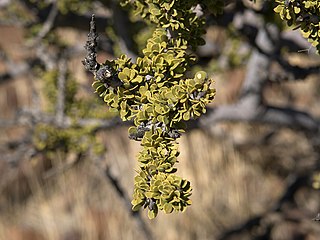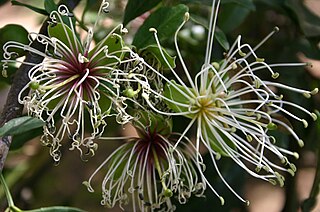
The Restionaceae, also called restiads and restios, are a family of flowering plants native to the Southern Hemisphere; they vary from a few centimeters to 3 meters in height. Following the APG IV (2016): the family now includes the former families Anarthriaceae, Centrolepidaceae and Lyginiaceae, and as such includes 51 genera with 572 known species. Based on evidence from fossil pollen, the Restionaceae likely originated more than 65 million years ago during the Late Cretaceous period, when the southern continents were still part of Gondwana.

Gentianaceae is a family of flowering plants of 103 genera and about 1600 species.

Carl Borivoj Presl was a Czech botanist.

Achariaceae is a family of flowering plants consisting of 31 genera and about 155 species of tropical herbs, shrubs, and trees. The APG IV system has greatly expanded the scope of the family by including many genera previously classified in Flacourtiaceae. Molecular data strongly support the inclusion of this family in the order Malpighiales.

Rhabdodendron is a genus of flowering plant in the family Rhabdodendraceae. It comprises three species of tropical South American trees.

Cleome is a genus of flowering plants in the family Cleomaceae, commonly known as spider flowers, spider plants, spider weeds, or bee plants. Previously, it had been placed in the family Capparaceae, until DNA studies found the Cleomaceae genera to be more closely related to the Brassicaceae than the Capparaceae. Cleome and clammyweed can sometimes be confused.

Boscia is a genus of plants in the family Capparaceae. It contains the following species:

Cadaba is a genus of shrubs in family Capparaceae, with about 30 species. These have simple, alternately set leaves. The zygomorphic flowers, are solitary or stand in small clusters at the end of short side branches. These flowers consist of four sepals, none or four petals with a narrow claw at base and a wider plate at the top, a tube-shaped nectar producing appendix, four or five stamens that are merged for about half their length into a so-called androgynophore, and a gynophore on top of which will develop a cylindrical capsule with one or two cavities that contain many small kindney-shaped seeds, and opens with two valves. The genus name Cadaba is derived from the Arab word "kadhab", a local name for Cadaba rotundifolia. Some species are classified as famine food in southern Ethiopia.

Capparis is a genus of flowering plants in the family Capparaceae. It includes 142 species of shrubs or lianas which are collectively known as caper shrubs or caperbushes. Capparis species occur over a wide range of habitat in the subtropical and tropical regions of Africa, Eurasia, Australasia, and the Pacific.

Fagraea is a genus of plants in the family Gentianaceae. It includes trees, shrubs, lianas, and epiphytes. They can be found in forests, swamps, and other habitat in Asia, Australia, and the Pacific Islands, with the center of diversity in Malesia.

Maerua is a genus of flowering plants in the family Capparaceae. It includes 70 species of shrubs and small trees with its centre of diversity in Africa, though some species extend their range as far north as the Levant, and as far east as the Indian subcontinent and mainland Southeast Asia.
Neuburgia is a genus of plants in the family Loganiaceae. It is native to the Bismarck Archipelago, Caroline Islands, Fiji, Maluku Islands, New Caledonia, New Guinea, Philippines, Solomon Islands, Sulawesi, and Vanuatu. It contains the following species :
ErnestFriedrich Gilg was a German botanist.

Nymphaea nouchali, often known by its synonym Nymphaea stellata, or by common names blue lotus, star lotus, red water lily, dwarf aquarium lily, blue water lily, blue star water lily or manel flower, is a water lily of genus Nymphaea. It is native to southern and eastern parts of Asia, and is the national flower of Bangladesh and Sri Lanka. In Sanskrit it is called utpala. This species is usually considered to include the blue Egyptian lotus N. nouchali var. caerulea. In the past, taxonomic confusion has occurred, with the name Nymphaea nouchali incorrectly applied to Nymphaea pubescens.

Crateva is a genus of flowering plants in the caper family, Capparaceae. It includes 21 species which range through the tropical regions of the world, including the tropical Americas, sub-Saharan Africa, the Indian subcontinent, Indochina, southern China, Japan, Malesia, Papuasia, Queensland, and the South Pacific.
Thilachium is a genus of flowering plants belonging to the family Capparaceae.
Symphyllophyton is a genus of flowering plants belonging to the family Gentianaceae.

Caloncoba is a genus of flowering plants belonging to the family Achariaceae.

Ritchiea is a genus of flowering plants belonging to the family Capparaceae.














